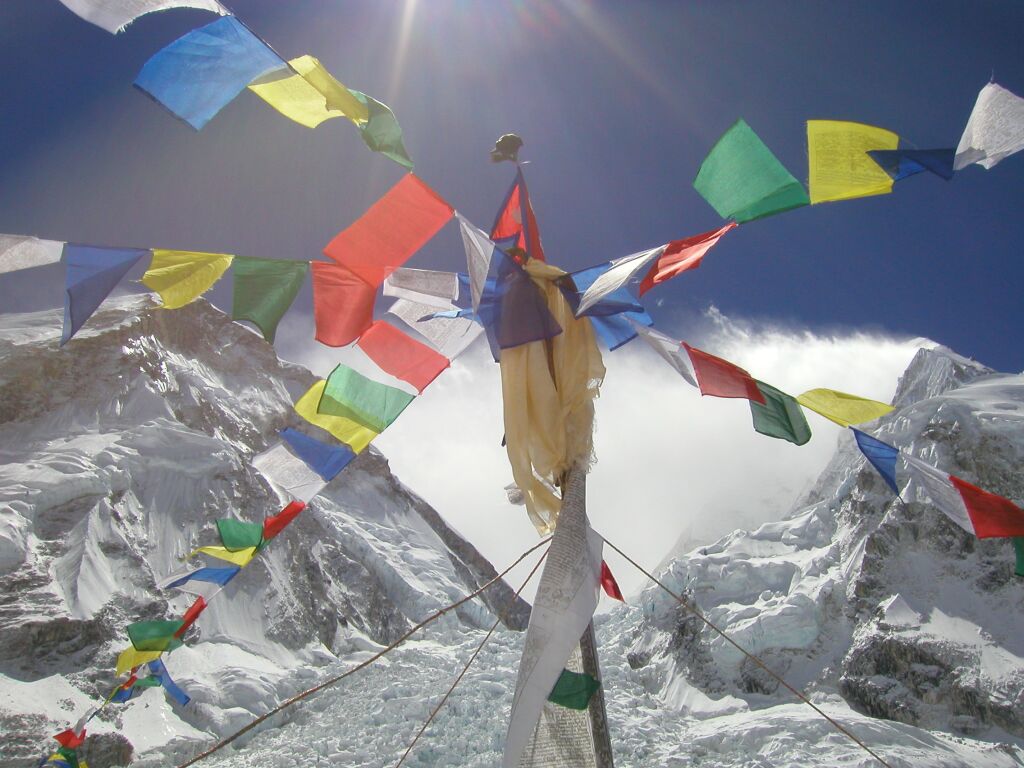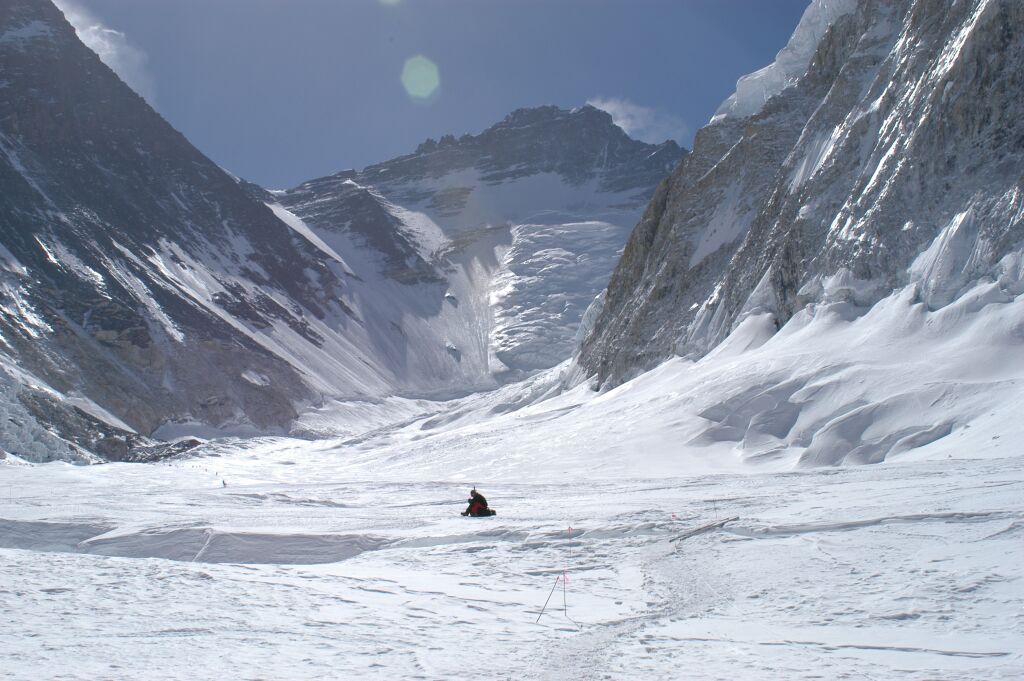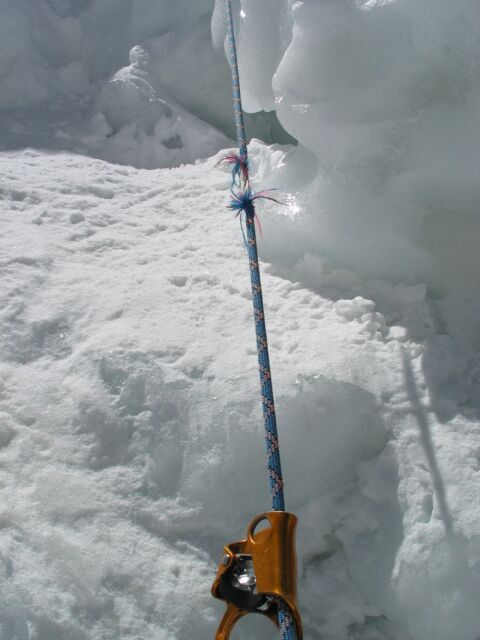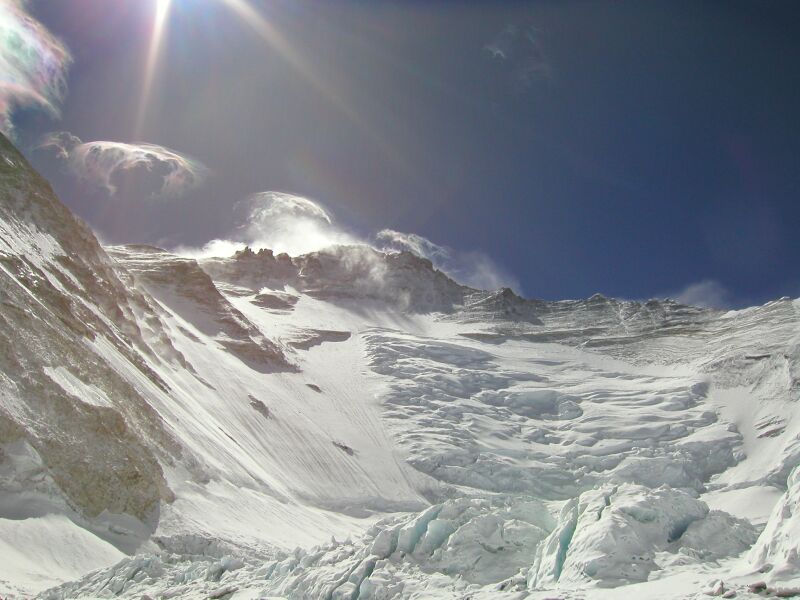扫一扫,手机访问本帖 
|
原贴链接:
http://www.clubtread.com/articledetail.asp?ID=33
Author Robin Walshaw (aka Rapscallion)

The trek in to Base Camp - A view of Ama Dablam
In a lifetime there are perhaps but a handful of moments when you walk along the knife edge of fate and destiny. Moments when you know that from this moment on things will be irrevocably different. No matter the vagaries of life, this is the instant when a choice you make matters. Really matters. My seminal moment came in the darkest night of my life at 8,500 meters on the summit ridge of Mount Everest. This is the story of how I got there.
A year ago the phone rang. When I put the phone down, my life was never to be the same. Alex Harris, a close friend since my elementary school days, invited me to climb Denali in Alaska with a group of climbers who I had climbed with for over 15 years all around the world. The group was a team he had assembled from South Africa’s mountaineering community. It comprised of good friends who knew each others limits and abilities intimately. It was also a group he was planning to lead on the South side of Everest.

My tent at basecamp
But why was I coming along I asked myself? I no longer lived in South Africa and now called Vancouver my new home. The sponsors wanted a truly South African team. Pushing this to the back of my mind I eagerly joined the team in Anchorage and enjoyed 11 days of great weather as we pushed to the summit of North America’s highest peak. Three weeks after returning from Denali the phone rang again. The team had decided that I had made a very strong showing on the mountain and that they wanted me to join them as a climbing member of the Discovery Everest 2003 Expedition.
I was speechless…a state most people find me in far too frequently. I related the news to my wife and watched as she gamely forced a smile onto her face and tried to hide the slow well of tears in her eyes. She knew what lay ahead all too well - I had attempted Everest once before from the North side. The year had been 1996, a year imprinted into the minds of mountain aficionados and lowlanders alike. It was the year of the storm.

Prayer flags at Base Camp
In 1996 we attempted the North side of Everest totally unsupported and without oxygen. No sherpas, no oxygen, no money. Perhaps even no brains. It was a challenging combination for a group of climbers none of whom had reached their 26th birthday. We were not successful that year, but came home with the thing we valued most – our lives.
The strain on my family in 1996 had been immense, could I put them through it all again? I have always tried to live life and seize opportunity as it arose. Everest again was too sweet a prize to ignore. After talking to my family I agreed to go and climb the monster.
I sweated and grunted through at least 223 individual training sessions before we left for Everest. Physically and mentally I was as strong as I could be…I promised myself that if the stars all aligned and the correct opportunity arose that I would not fail because I had not prepared sufficiently.

Alone in the Western Cwm
I met the team in Khatmandu, and we left its dusty streets shortly after our arrival. Meeting up with the team was a walk down memory lane. Many of them I had known since I was 13. We had been best friends and even best men to each other. I could not ask to climb Everest with a closer group of friends.
The hike into Everest base camp alone is worth the trip to Nepal. Spending nights in Sherpa villages and warming yourself over yak dung fires while the world’s most magnificent mountain range towers above you is in itself a memory to cherish. After 8 days of interesting and varied trekking we caught our first site of the dreaded Khumbu icefall just above Everest Base Camp. The Khumbu icefall is regarded as one of the most deadly areas on the south side of Everest. My first glimpse of a place I had heard so much about came quite unexpectedly.

Taking a quick breather before continuing on to Camp 1
We had been following a trail along a broken moraine above the lower portion of the Khumbu glacier. Negotiating the trail required some dexterity. The path was only two feet wide which under different circumstances would have been no problem. But when confronted by 250 kilograms of irate hoof, hair and horns it’s easy to see how the path seems not at all large enough for everyone. Learning to avoid the yak trains became a skill and a challenge towards the later parts of the trek, and it was just after avoiding one such convoy that I laid eyes on the icefall.
How it came by its fearsome reputation was easy to see. It was a white sea of icy boulders, a ponderous wave of crumbled glacier that threatened to crash down and crush the insignificant humans who scurried beneath it. By the end of the expedition I had struggled and strained through the icefall over 10 times, and each time my trepidation about my safety increased.

The icefall complete with tiny climbers
Perched on the lower tongue of the Khumbu glacier, Everest base camp is not really the place I would chose to spend 70 days under any circumstances. Boulders churned up by the slow but unstoppable movement of the glacier remain frozen in place on its icy surface, embedded still after thousands of years slow progress towards the sea.
By now we were all feeling the affects of the rarified air at base camp. We were after all living at 5,300 meters. Walking more than a few yards was a chore, and when it came time to establish the communications tent and setup latrine facilities my head was pounding to the thudding beat of an altitude drum.
At 4:00 AM one morning we began our first foray into the icefall. I was unsure what to expect, and accounts varied regarding the routes condition. Even though I had read books and lived beneath it for almost two weeks I was little prepared for the task that awaited me.

A rope too far - unreliable fixed ropes on the icefall
By the glow of our headlamps we reached the base of the fixed ropes at the start of the icefall. Our objective was to push through the icefall and dump a load of gear at the proposed spot for Camp 1 at 6,100 meters. Dawn was fighting against the darkness on the distant horizon but the icefall still appeared as a brooding shapeless mass.
The next 10 hours proved to be more taxing than I could have believed. I always acclimatize more slowly than most, but even taking this into account, the weaving and treacherous route through the icefall fatigued me in a way I had thought wasn’t possible. In the first hour or so, clambering over house size chunks of broken ice, my breathing was measured and my pace good. In the second hour both of those became strained. By the time I reached the fourth hour I was climbing ten steps and resting 10 breaths. By the sixth hour I was down to 5 and 5.
Negotiating the icefall requires a climber to clip into a set of fixed ropes that weave in and out of a confusion of rotten ice boulders. At times the route is vertical, at others no more than 30 degrees. Concentration is the key element when climbing the icefall. One mistake, one misplaced foot or misclipped biner and your fate could be sealed permanently. Just like your coffin.

Ladder crossing in the icefall
Steel ladders lashed together with lengths of rope spanned yawning crevasses that seemed to have no bottom. Traversing the ladders became an art which we all became extremely practiced at. Using crampons to span the rungs of the ladder you clip into a safety line and slowly edge forward, all the while trying to ignore the hungry void below. Just as you reach a point where two ladders are lashed together the ladders begin to yaw perceptibly and the safety line begins to look like a poor substitute for solid ground.
As the sun rises over the icefall, the crisp air of the morning dissipates and the harsh reality of climbing under a high altitude sun begins to bite. Early that morning we had set off when the temperature was a cool -28 degrees. By the time we neared the top of the icefall and traversed over 50 ladders it was now closer to 30 degrees.
After negotiating a particularly tricky crevasse at the head of the Western Cwm it’s a mere hour up to Camp 1. I staggered into Camp 1 absolutely exhausted and breathing like a flogged racehorse. It took me just under 8 hours to reach Camp 1 the first time. By the end of the expedition I was reaching Camp 1 in well under 4 hours.

Camp I destroyed after the storm
You do not so much as climb Mount Everest as lay siege to it. Climbing any of the 8000ers requires the effective stocking of camps and a slow but steady acclimatization process. Both of those are key to a successful expedition. Without a well thought out acclimatization plan you might as well kiss the summit goodbye, and perhaps your life.
A fit healthy young man transported from Vancouver or Calgary to the summit of Everest will fall into a coma in 15 minutes. Before 30 minutes are up he will probably be dead. Going slow and acclimatizing effectively is not recommended, it’s required.
Camp II lay 4 hours beyond Camp I under the shadow of Nuptse and Lhotse. Situated close to the start of the Lhotse face, the time spent at Camp II is second only to the amount of time spent at base camp. Reaching Camp II requires trudging through the Western Cwm which can only be described as the world’s largest parabolic reflector. If the sun is high then you know its cooking in the Cwm.

The Lhotse face and Camp III
Tracing the route up the Lhotse face while at Camp II is intimidating in the extreme. After trudging to the base of the bergschrund, the route seems to go straight up the nasty blue ice of the Lhotse face. Camp III at 7,300 meters on the Lhotse face is almost indiscernible, dwarfed by the sheer size of the surrounding mountains.
After a number of trips to Camp II we decided to ascend to Camp III and drop a load. The fixed ropes ascend almost directly up the Lhotse face without respite. Clipping to the rope with your jumar you fall into a rhythm of rasping breaths and crunching ice. Your fingers go numb, but that’s OK because they are still a little sore. Painful fingers probably mean that you don’t have frostbite. Yet.
After four hours on the ropes visibility dropped to 10 meters. The wind picked up and the temperature plummeted. Out of the iciness staggered a team of Indian army climbers. Their expedition leader stopped me as we passed on the fixed rope. His beard was full of hoar frost and his eyelids were caked with ice. I tried to ignore the pained but glazed look in his eyes. “Go down!” he screamed. Though we were only centimeters apart the wind whipped his cry away. “Go down!”

Welcome to Camp III
I looked around in vain for my team. Over the last few hours we had become separated as we aligned to our natural paces in order to keep warm. I was entering the danger zone. Uncontrollable shivers shook my body and my fingers were no longer painful. I couldn’t feel them or manipulate the rope properly. I pulled off one of my three layers of gloves and stuck my fingers under my armpits. They where like ice cubes. I was in trouble. I debated going down or carrying on. I couldn’t see Camp III through the swirling snow and I was tired. So very, very tired.
I decided that going up was the best option, relying on the hope that Camp III was not too far away. After ascending a polished and treacherous section of blue ice I caught a fleeting glimpse of Camp III. Shrouded in ice and moaning like a ghost I eventually lurched into Camp III. The rest is a blur…all I knew is that I was safe.
Later we learned that the whole upper section of Everest had been pummeled by an aggressive storm which we had been fighting through the heart of. Other climbers related how they had stared up at our progress until we were lost in the storm and wondered if we would survive to tell the tale.

On oxygen on the way to Camp IV
We did survive, and after descending and resting at base camp we decided that the weather reports augured well for a summit bid. We eased through the icefall and past Camp 1, going directly to Camp II – something that would have been an absolute impossibility 4 weeks ago.
The 20th May was a landmark in my climbing career - for the first time I strapped on the same oxygen equipment used by MiG fighter pilots as they soar through the upper layers of the earth’s atmosphere and began to crampon my way up the cold blue ice of the Lhotse face at 7,300 meters. Within moments of starting my ascent my heart rate changed from a soporiphic thump to a frantic beating that echoed in my ears and made me gasp like a man near death. In hindsight, perhaps I was closer to this then I dare think about.
The muscles in my legs thrummed with lactic acid after months of abuse and toil at high altitude. My mind was foggy…something was wrong. Very wrong. My breathing had moved beyond labored into a nightmare of total hypoxia. The climber in the blue down suit ahead of me blurred slightly and then all I saw was white. What breath remained in my lungs was rudely expelled as I hit the ice chest first. Within moments I had gained terrifying momentum on the 60 degree ice face. I blindly lunged with my ice axe but it bounced ineffectual off the ice. Just as my mind began to numbly grasp my peril I jerked to a halt. The old, tattered rope I had clipped on to pulled taunt leaving me dangling above a 500 meter death slide.

Spent and exhausted at Camp IV it took all my will just to undress
I shook my head, trying to clear it of the strange haziness that made me feel lethargic and uncaring. Something was wrong. Oh yes, I was swinging with carefree abandon above a drop that would add me to the alarmingly long list of Everest fatalities. Sweating in my down suit I managed to dig my front points into the ice and gain a modicum of safety. It dawned on me then…I was struggling desperately to breathe. Laboriously I swung off my backpack and fumbled with the gauge on my oxygen cylinder. It was turned off. I had been climbing without oxygen and weighted down with a heavy pack.
Turning the flow rate to 1.5 liters a minute I basked in the flow of what seemed a totally hedonistic supply of the good stuff – life giving oxygen. After a grueling and often tense day we established our high camp at 8,000 meters on the South Col of Everest. By the time we arrived the wind was already funneling across the South Col. The wind was insidious, weaving its way easily through both down and gortex. It was beyond cold.
I stumbled around like a drunkard as we established camp, the spiteful wind making erecting tents a frustrating and exhausting task. Eventually the tent was ready and I fell into it exhausted, feet half out the tent. It took another 20 minutes before I worked up the energy to take my boots off. In my current state unpacking my sleeping bag seemed like a chore that the gods themselves would struggle to complete.
At 9:15 PM on the 21st May we strapped on our oxygen equipment, battled into suits of down armour and walked off into the darkest night of my life. We had consulted numerous weather reports all of which indicated that today would likely be the best weather day for a summit bid. An eerie stillness blanketed our camp at 8,000 meters. Turning on our headlamps we headed up towards the very roof of the world. Within moments of leaving our tents the wind picked up, the buffeting causing us to sway (dangerously) like drunkards. Soon the buffeting turned into a battering as we turned our heads and bodies away from the freezing wind. What had been just a very cold wind turned into deathly gale. We continued up a gully of ever steepening snow that could only accommodate one person at a time. The wind began to take it's toll, first Sean Disney turned back - his face frozen into a rictus of pain by the wind. Then it was Deshun Deysul's turn to bow out. Alex Harris, Sean Wisedale and I carried on, the three of us were feeling strong despite the wind and altitude. It soon became obvious to me how cold it really was - my watch froze over and my energy gels became a solid mass. Not really remarkable until you consider that this only becomes possible at temperatures below -40 Celsius. Alex paused as we ascended to rub his eyes repeatedly - they had frozen shut.

Soon the three of us were on our own in the dark and the cold - everyone else had retreated. Never have I felt so disconnected from the world, alone and in danger. We were near 8,500 meters on the world’s highest mountain in the worst possible conditions, a paltry 350 meters from the summit. As we carried on ascending we discovered that the sherpas given the responsibility of fixing the ridge had turned around because of the freezing conditions and dangerous winds. Reaching the height where the fixed ropes ended we sat down to a shivering conference, only being kept in place by the grip of our crampons and our hold on the fixed ropes. This was the moment when fate and destiny stood looking over our shoulders. This was the moment that counted.
Our position was a precarious one - we could continue as the weather worsened with the very real possibility of death, or turn around and possibly end our expedition after 65 days of exhausting effort. We thought about our loved ones and the risk we were facing - the choice was made then. We turned back into the wind and descended. Just to add further excitement (like we needed it) my headlamp blinked and went lifeless. I now had to descend in the dark. Needless to say the descent was epic and outrageously frightening. By the time we tumbled into the tent we were covered in frost and ice from head to toe and close to our end.
Later we learnt we had passed all other teams on our ascent and forged a path for the rest to follow. Long after everyone else had turned around we had soldered on - but it wasn't enough. The weather and our experience made us turn around instead of facing potentially fatal consequences. The next day we decided that we had been hammered by the weather beyond the ability to recover at high altitude, so our only option was to descend down the mountain to the more clement altitude of base camp.

The team
At base camp we decided as a team that our safest option was to return home - our minds and bodies having been weakened by the continued stress of cold and major physical exertion. Another summit attempt would place our lives at significant risk due to fatigue.
Reaching 8,500 meters, a few hours from the summit of Everest, had been one of the most frustrating and exhausting epics of my life. My desire and strength to reach the summit was still strong after our second summit bid and I burned with the desire to try again. But at what cost? My life? Permanent frostbite damage? Something's are worse sacrificing for...but only if it is for the people you love.
There is so much to tell of my story on Everest. 2 tons of equipment, 70 days of cold and fear, 5 deaths, innumerable rescues, chanting Llamas, praying Rabbi’s, skiing monks, the worlds highest game of cricket. The story goes on and on…
So it was with a heavy heart that we left base camp having not reached the summit through what can only be described as meteorological bad luck...but what an experience! Good company, amazing mountain scapes and memories for a lifetime. My moment had come and I chose my fate. No regrets, just thoughts of what if... |
|